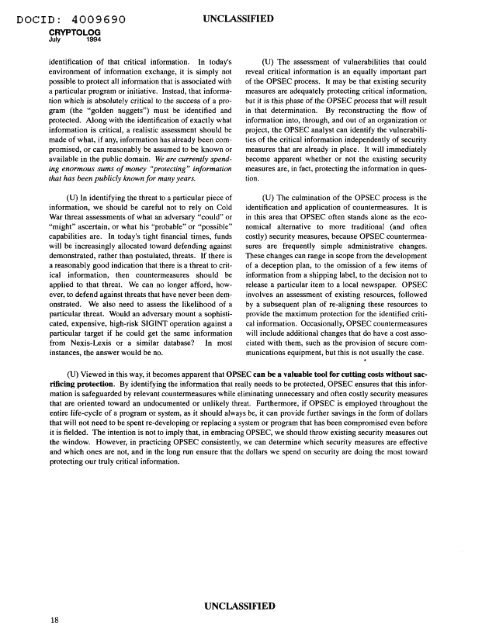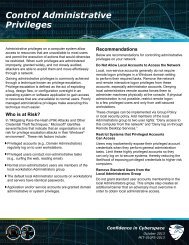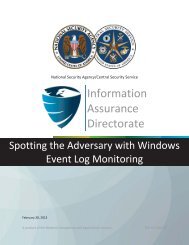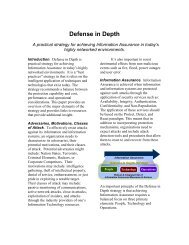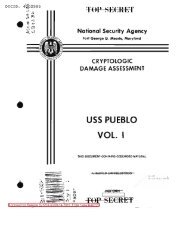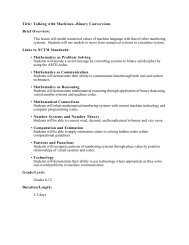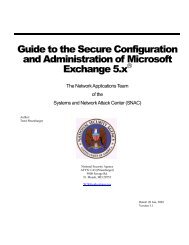CRYPTOLOG - National Security Agency
CRYPTOLOG - National Security Agency
CRYPTOLOG - National Security Agency
You also want an ePaper? Increase the reach of your titles
YUMPU automatically turns print PDFs into web optimized ePapers that Google loves.
DOCID: 4009690<br />
CRVPTOLOG<br />
July 1994<br />
identification of that critical information. In today's<br />
environment of information exchange, it is simply not<br />
possible to protect all information that is associated with<br />
a particular program or initiative. Instead, that information<br />
which is absolutely critical to the success of a program<br />
(the "golden nuggets") must be identified and<br />
protected. Along with the identification of exactly what<br />
information is critical, a realistic assessment should be<br />
made of what, if any, information has already been compromised,<br />
or can reasonably be assumed to be known or<br />
available in the public domain. We are currently spending<br />
enormous sums ofmoney "protecting" information<br />
that has been publicly known for many years.<br />
(U) In identifying the threat to a particular piece of<br />
information, we should be careful not to rely on Cold<br />
War threat assessments of what an adversary "could" or<br />
"might" ascertain, or what his "probable" or "possible"<br />
capabilities are. In today's tight financial times, funds<br />
will be increasingly allocated toward defending against<br />
demonstrated, rather than postulated, threats. If there is<br />
a reasonably good indication that there is a threat to critical<br />
information, then countermeasures should be<br />
applied to that threat. We can no longer afford, however,<br />
to defend against threats that have never been demonstrated.<br />
We also need to assess the likelihood of a<br />
particular threat. Would an adversary mount a sophisticated,<br />
expensive, high-risk SIGINT operation against a<br />
particular target if he could get the same information<br />
from Nexis-Lexis or a similar database? In most<br />
instances, the answer would be no.<br />
UNCLASSIFIED<br />
(U) The assessment of vulnerabilities that could<br />
reveal critical information is an equally important part<br />
of the OPSEC process. It may be that existing security<br />
measures are adequately protecting critical information,<br />
but it is this phase of the OPSEC process that will result<br />
in that determination. By reconstructing the flow of<br />
information into, through, and out of an organization or<br />
project, the OPSEC analyst can identify the vulnerabilities<br />
of the critical information independently of security<br />
measures that are already in place. It will immediately<br />
become apparent whether or not the existing security<br />
measures are, in fact, protecting the information in question.<br />
(U) The culmination of the OPSEC process is the<br />
identification and application of countermeasures. It is<br />
in this area that OPSEC often stands alone as the economical<br />
alternative to more traditional (and often<br />
costly) security measures, because OPSEC countermeasures<br />
are frequently simple administrative changes.<br />
These changes can range in scope from the development<br />
of a deception plan, to the omission of a few items of<br />
information from a shipping label, to the decision not to<br />
release a particular item to a local newspaper. OPSEC<br />
involves an assessment of existing resources, followed<br />
by a subsequent plan of re-aligning these resources to<br />
provide the maximum protection for the identified critical<br />
information. Occasionally, OPSEC countermeasures<br />
will include additional changes that do have a cost associated<br />
with them, such as the provision of secure communications<br />
equipment, but this is not usually the case.<br />
(U) Viewed in this way, it becomes apparent that OPSEC can be a valuable tool for cutting costs without sac·<br />
rificing protection. By identifying the information that really needs to be protected, OPSEC ensures that this information<br />
is safeguarded by relevant countermeasures while eliminating unnecessary and often costly security measures<br />
that are oriented toward an undocumented or unlikely threat. Furthermore, if OPSEC is employed throughout the<br />
entire life-cycle of a program or system, as it should always be, it can provide further savings in the form of dollars<br />
that will not need to be spent re-developing or replacing a system or program that has been compromised even before<br />
it is fielded. The intention is not to imply that, in embracing OPSEC, we should throw existing security measures out<br />
the window. However, in practicing OPSEC consistently, we can determine which security measures are effective<br />
and which ones are not, and in the long run ensure that the dollars we spend on security are doing the most toward<br />
protecting our truly critical information.<br />
18<br />
UNCLASSIFIED


